Burned out Bugs…
…brainwashing the kids
Introduction: VW’s Diesel Deception and EVisceration
Remember VW’s “Dieselgate”, where VW was caught cheating on the emissions of their “Clean Diesels” using a Bosch software tweak? With $38 billion or so in fines to date, VW’s Diesel Deception has precipitated an avalanche of hugely expensive lawsuits worldwide, which continue today, and has affected every car maker worldwide that manufactures or manufactured a diesel vehicle. Most recently, Cummins was “busted” and fined A STAGGERING AMOUNT OF MONEY for their Ram truck emissions scandal.
WOW ! $15 billion in fines in the USA and counting, with recent worldwide estimates now a staggering $38 Billion + !
After the all-in pivot to EVs, VW has suffered from an unrelenting decline in EV sales and assembly line shutdowns, as Germans and people worldwide have woken up (the real “woke”) to the realization that overweight EVs have limited range, suffer expensive breakdowns, and are particularly costly to run because of ultra-expensive German electricity.
VW EVs also feature buggy (pun) software, causing further tumult amoung early adopters, per this sadly amusing video:
Above video: VW EV’s buggy software causing Dieter Trauma
Above: VW’s EVs are also gaining a reputation worldwide for catching on fire while charging, in addition to other hardware and fire related recalls.
Above video: - GRONINGEN - an electric car, a Volkswagen ID 3, caught fire at the end of the morning. The driver had just put her child in the car and wanted to get behind the wheel herself. She took the charging plug out of the car. Then the car started smoking. She quickly got her child out of the car and got herself to safety. The flames quickly burst out of the car.
The German car industry is the largest employer in Germany and represents perhaps its largest single industrial base, generating over 500 Billion Euros in 2022, and thus holds some leverage over a subset of the Kray Kray Green Movement; guided by the Inane Energiewende Roadmap, the Putin/Merkel backed fiasco meant to “decarbonize” Germany’s primary energy supply, and as aided and abetted by the anti-nuclear Green Party. Now Germany is facing budget shortfalls, burning more coal and wood pellets for heat, while the average citizen “freezes A”.
Further, because of the Energiewende, the German car industry now faces sigificant economic challenges, contradictions and conflicts, in addition to a confusing confrontation with its own car culture and car enthusiasts. For an overview of the German car industry, please see pdf below, if you can stand it:
The costly Dieselgate Sprockets Humiliation has also unfortunately catalyzed the destruction of the diesel market worldwide and the uptake of efficient and torquey diesel cars and trucks. Since then, after a brutal shaming, VW has “reshaped” their company and pivoted to “clean” EVs, featuring yet another deception with regards to the true nature of EV CO2 emissions, which is the ultimate subject of this article.
I am so depressed: $38 Billion lost.
VW EV Phoenix Rises from the Dieselgate Debacle
Actual VW Phoenix camper from 1971!
VW has undergone a “pivot” to EVs after destroying the diesel market worldwide, and now sells a full menu of EVs with limited success and plenty of issues, as described prior. For more exciting information on the VW pivot to EVs see Forbes: “From Emissions Cheater To Climate Leader: VW’s Journey From Dieselgate To Embracing E-Mobility”
What is not talked about is the EV emissons cover-up, the subject of this article, starting below.
The VWs EV Emissions Cover-up and the Two Missing VW Lifecycle Analyses
Given all the Warm and Fuzzy Dialogue and BS and the throng of new BEVs from VW, we decided to review two previously “published” VW Lifecycle Analyses (LCAs) that Greenwash the actual VW EV CO2 emissions.
We reviewed the flawed VW “cradle to grave” emissions LCAs of the VW EVs, and then compared those to a Real World and Real Car Volvo LCA which showed that actual BEV GHG emissions are far higher than thought previously due to the battery manufacturing.
Interestingly, we discovered that the two VW EV LCAs previously published had disappeared from the internet:
1) “From the Well to the Wheel”
2)“E-mobility is already this much more climate-neutral today”
Above: Arte Johnson from Laugh-In
Found! The Two Missing VW EV LCAs
“From the Well to the Wheel” found at web.archive.org (the interweb is forever)
and
“E-mobility is already this much more climate-neutral today” reprinted in some part at electriccarsreport.com
(Kudos to Tian Wen of Debunking the Debunkers)
What do the Two Missing VW LCAs Say about EV Emissions?
First VW LCA : “From the Well to the Wheel”
As shown below, compared to the banned Golf Diesel, the Golf EV (discontinued in 2020) produces almost 50 % more CO2 in the production phase due to the battery (see lower blue part of the bars)
As shown below, in the “Climate Footprint” to achieve the so-called carbon neutral crossover point, and neutralize all the planetary CO2 destruction from the battery, you have to drive the Golf EV 125,000 km (77,671 miles) using a realistic energy mix, not “pure renewables” such as wind or hydro.
As shown below, the CO2 emitted over a lifetime depends on electricity source, with wind power only being the lowest or about half of the diesel emissions. Note that the total CO2 emitted by BEVs from common energy mixes of coal, oil, nuclear, and some renewables approach exceed diesel (!) (top of the bars).
Second VW LCA: “E-mobility is already this much more climate-neutral today”
The new VW EV ID.3 is compared to the banned Golf Diesel and a petrol Golf in this LCA. The new VW EV ID.3 still produces almost 50 % more CO2 in the production phase due to the battery, but VW promises a 40 % reduction in that CO2 in the future. Exciting. Not.
So-called carbon neutral crossover point is not presented, or that we can find.
The CO2 emitted over a lifetime depends on electricity source. This LCA 2 CO2 data is presented in ton CO2 equivalent, while VW LCA 1 reports in grams/km. Whatever the case, eyeballing the data shows only modest reductions in CO2 over the lifetime of the car.
The Two VW LCA Conclusions
The battery contributes at least 50 % more emissions in the production phase compared to diesel or petrol cars.
To reach GHG neutral or crossover point, you need to drive the Golf EV 125,000 km or 77,671 miles compared the banned VW Golf diesel and likely the petrol car too, using the most common energy mixes.
If you live in Norway or some other Fantasy Land, and charge the EV with electrons from wind or hydro, then you can feel better about your CO2 emissions, and your contribution to GHGs is at least 50 % lower than other energy mixes.
NOTE: too bad Germany closed all it’s nuclear power plants - they could be charging the EVs.
How does the Real Car Real World Volvo LCA Compare to the VW LCAs ?
Volvo reports that GHG emissions from making the Volvo EVs are 70% higher than petrol models due to battery manufacturing. VW is 50 % higher compared to evil diesel. The Volvo 70 % number is due to the larger battery vs. the little Golf EV.
The Volvo best case GHG breakeven point for greenhouse gases is 30,450 miles using electricity from only “renewable” energy from Norway for example. VW?
Volvo BEV GHG breakeven using the EU 28 mix or global mix of electricity, i.e. coal, gas, nuclear, etc with a sprinkling of “renewables” is 47,845 miles and 68,350 miles respectively. VW breakeven is 125,000 km or 77,671 miles
VW and Volvo LCA Final Conclusions
The batteries, from the production phase, contribute from about 50 to 70 % more GHGs vs ICE vehicles over the cars lifetime (200,000 km), mostly depending on battery size and other materials involved.
The GHG breakeven can be as low as 30,450 miles if you live in Norway and charge your car with electricity from wind, hydro, etc. More realistically, you will be charging with a Rest of the World mix of energy, and the GHG breakeven may occur from about 48,000 miles to about 77,000 miles.
Importantly, all the hand wringing about BEVs, LCAs and GHGs won’t make any real difference in reducing GHGs anyway. How can that be? See next section.
End game: Basic Math shows that replacing all cars in the world with BEVs will make little difference in Global GHG Emissions
Why? Because automobiles and light trucks only contribute a small fraction of GHGs ( ca. 7 %) to the global total per EPA, BP, IEA and other data consolidator studies.
Per above, 11.9% of global GHG gases (CO2 mostly) arise from road transport. This includes emissions from burning of petrol and diesel from all forms of road transport which includes cars, trucks, lorries, motorcycles and buses.
Importantly, 60 % of road transport emissions come from passenger travel (cars, motorcycles and buses); and the remaining 40 % is from road freight (lorries and trucks).
The Arithmetic
0.60 * 12 x 100 = 7.2 % GHGs from passenger travel (cars, motorcycles and buses)
Final Thoughts
1) The VW LCAs were likely pulled from the InterWeb because they do not portray EVs in a positive GHG emissions light and they are also compared to VW diesels which represent VWs greatest humiliation. The VW Golf EV was discontinued.
2) The Real Car Volvo LCA is hard to find online as well, but is a mostly apples to apples comparison.
3) Replacing all of the world’s cars with EVs to lower GHGs is a worthless exercise - the slice of the GHG pie is miniscule compared to the other emitters, while the environmental and social costs of EV battery production are almost incalculable. EVs and batteries, and solar and wind further enable the world’s predator, China.







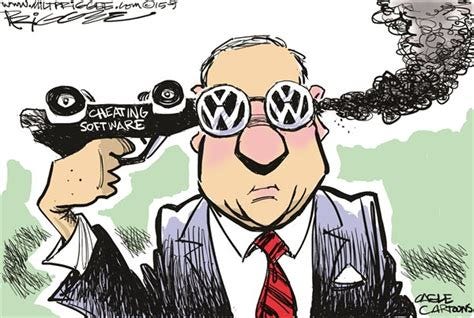
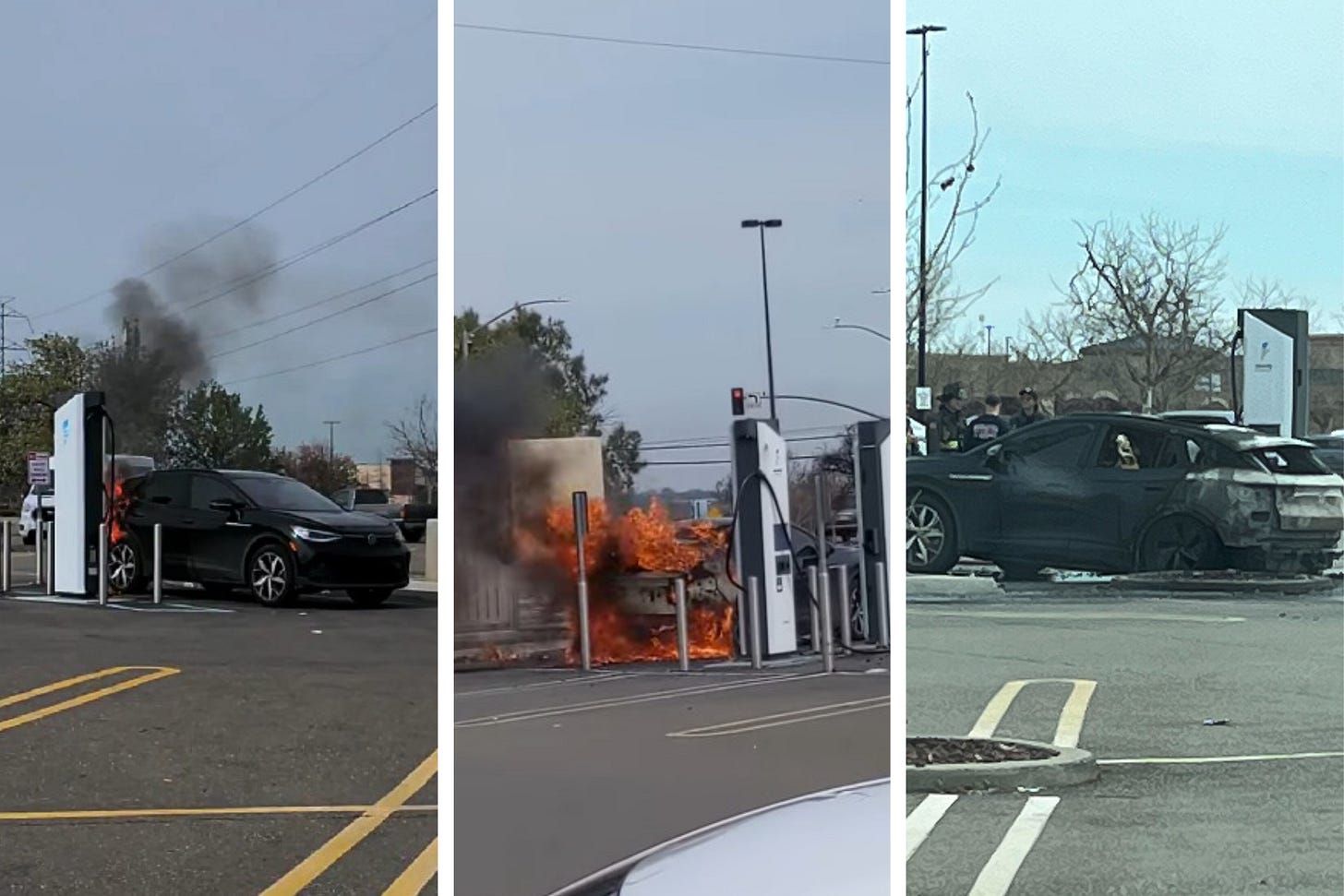





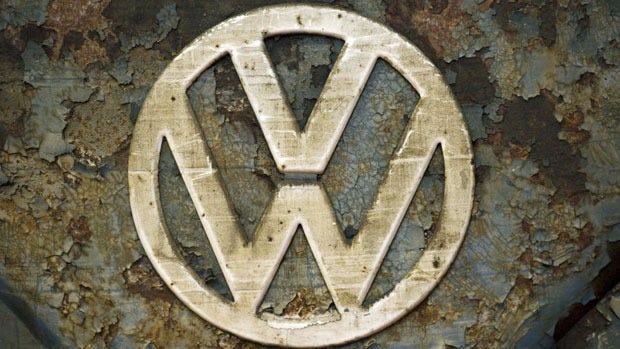



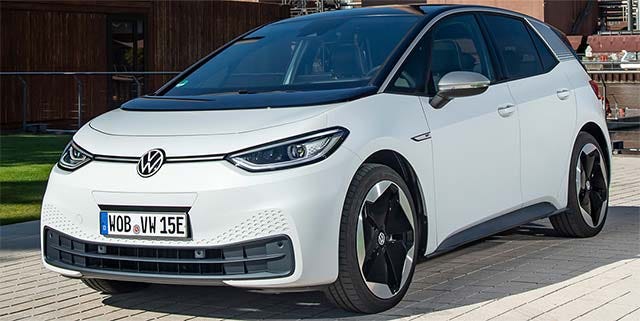
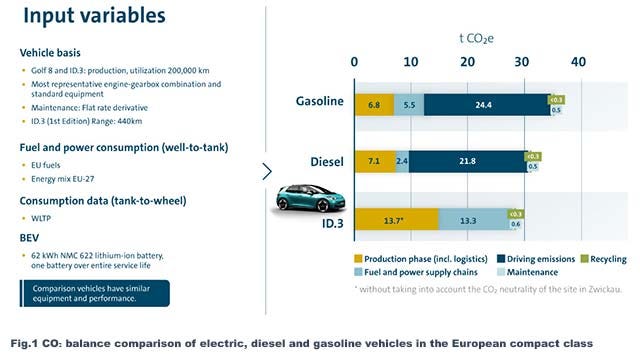

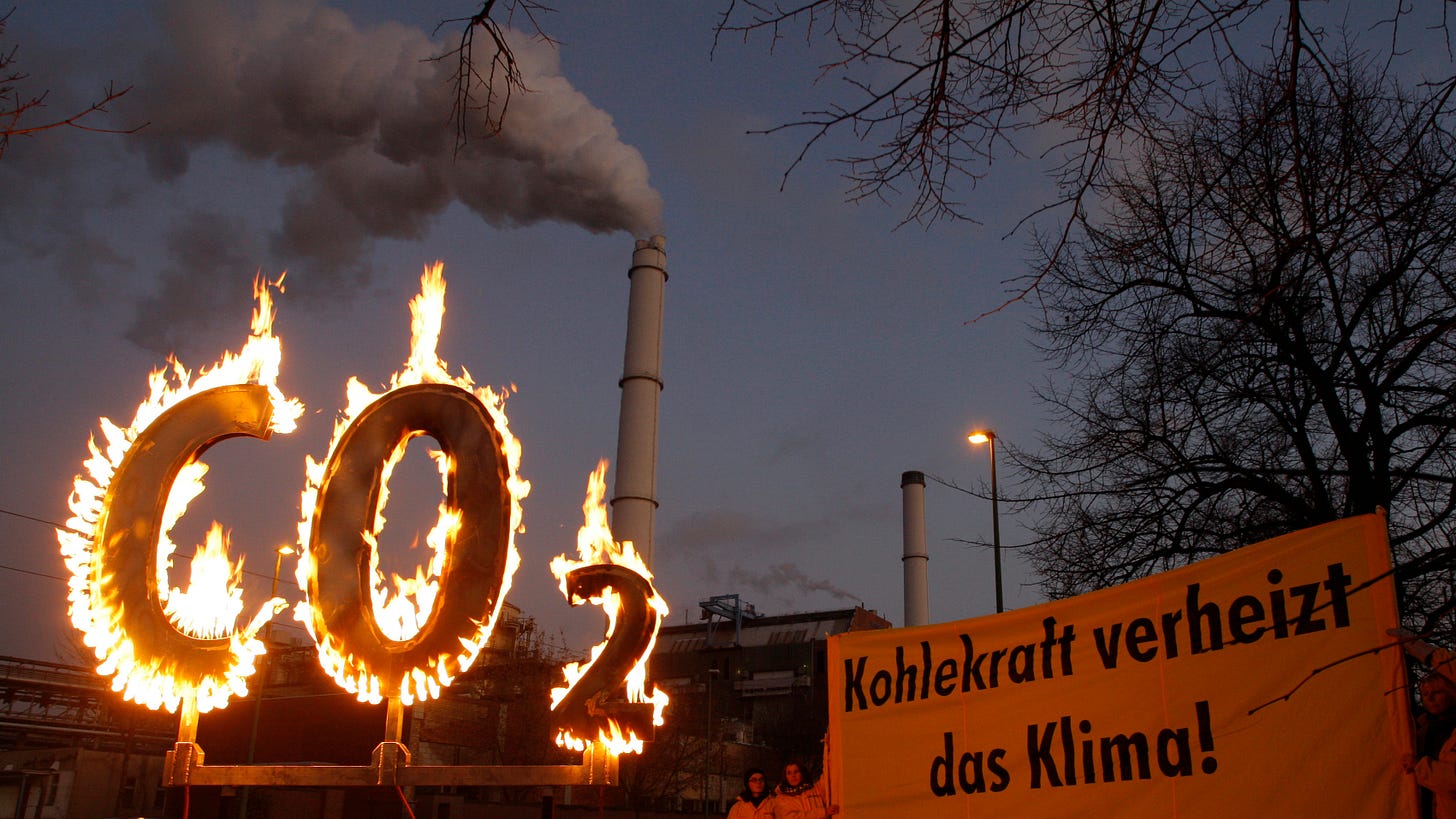

Great post TC and thank you for the shoutout!
Even more damning: EV cars are driven a lot less than ICE cars, at least in the US. EV cars are driven only 7,165 miles (11,265 km) per year compared to 11,642 miles (17,702 km) for ICE cars. To go back to your example, it would take nearly 11 years (!) before the total emissions of the Golf EV start to compare favorably to the Golf Diesel. How anyone can pretend EVs are "green" is beyond me.
The worst is that during those 11 years ICE cars will also get more efficient. Just look at what Toyota is doing with hybrids. So it's possible there won't be any actual emission reduction over the effective lifetime of an EV.
It is possible that at some point EVs will be fairly cheap (eg using iron batteries), batteries won’t catch fire, etc. But that’s not the case nowadays. Given these shortcomings and their limited environmental benefits, politicians should stop pushing EVs down people’s throats.
Source: https://mediarelations.gwu.edu/new-study-finds-electric-vehicles-are-driven-less-gas-cars
Great article. I just found your column and I have been enjoying your articles.
I don’t think Greens understand how incompatible solar, wind and coal are with electric vehicles. Coal because of the carbon emissions from both battery production and fueling, and solar/wind because they drive up the cost of electricity and intermittency.
https://frompovertytoprogress.substack.com/p/why-solar-wind-undermines-evs
I think a much better plan is to replace coal with a blend of natural gas, nuclear and hydro. The exact blend will vary based on geography and local cost structure. In the USA, natural gas is a no brainer because of its low cost.
https://frompovertytoprogress.substack.com/p/a-simple-and-cost-effective-plan
Only after that has been accomplished should we promote electric vehicles. The reality is that there is no reason to rush to purchase technologies before they are cost-effective. We do not need to get to Netzero by 2050, because there is no climate emergency. Removing coal from the grid comes first and solar and wind cannot so that.
https://frompovertytoprogress.substack.com/p/more-evidence-that-solar-wind-cannot